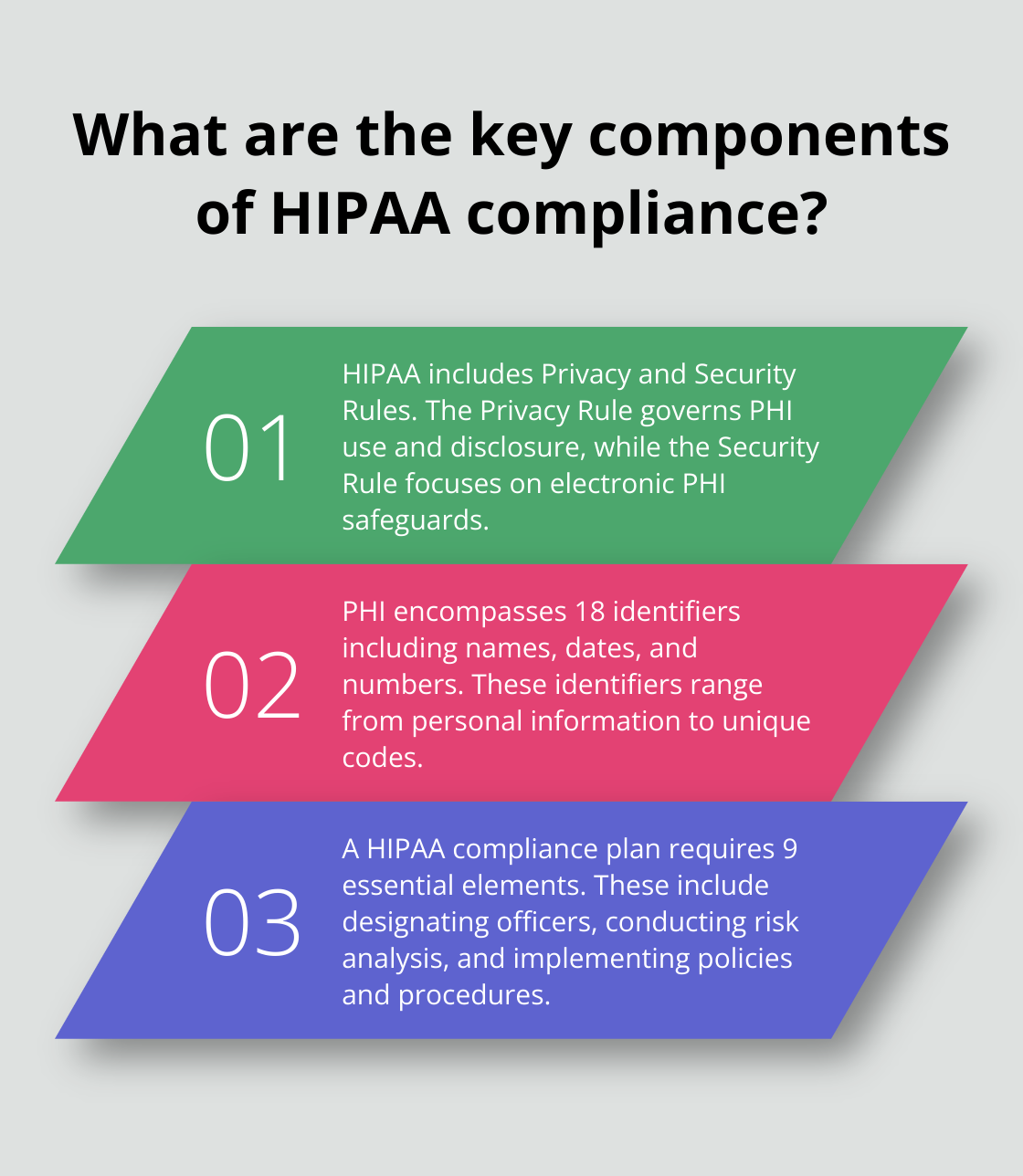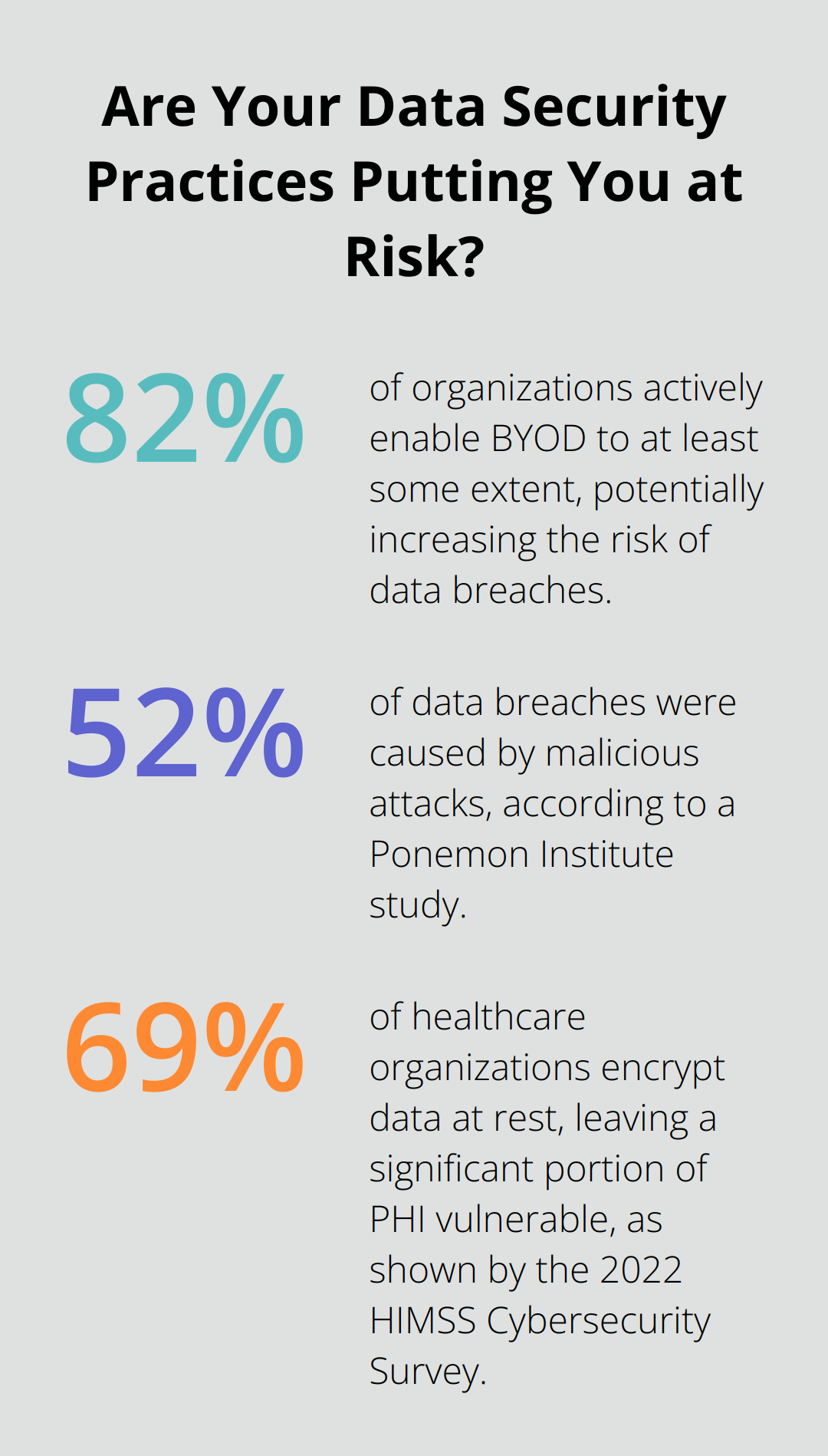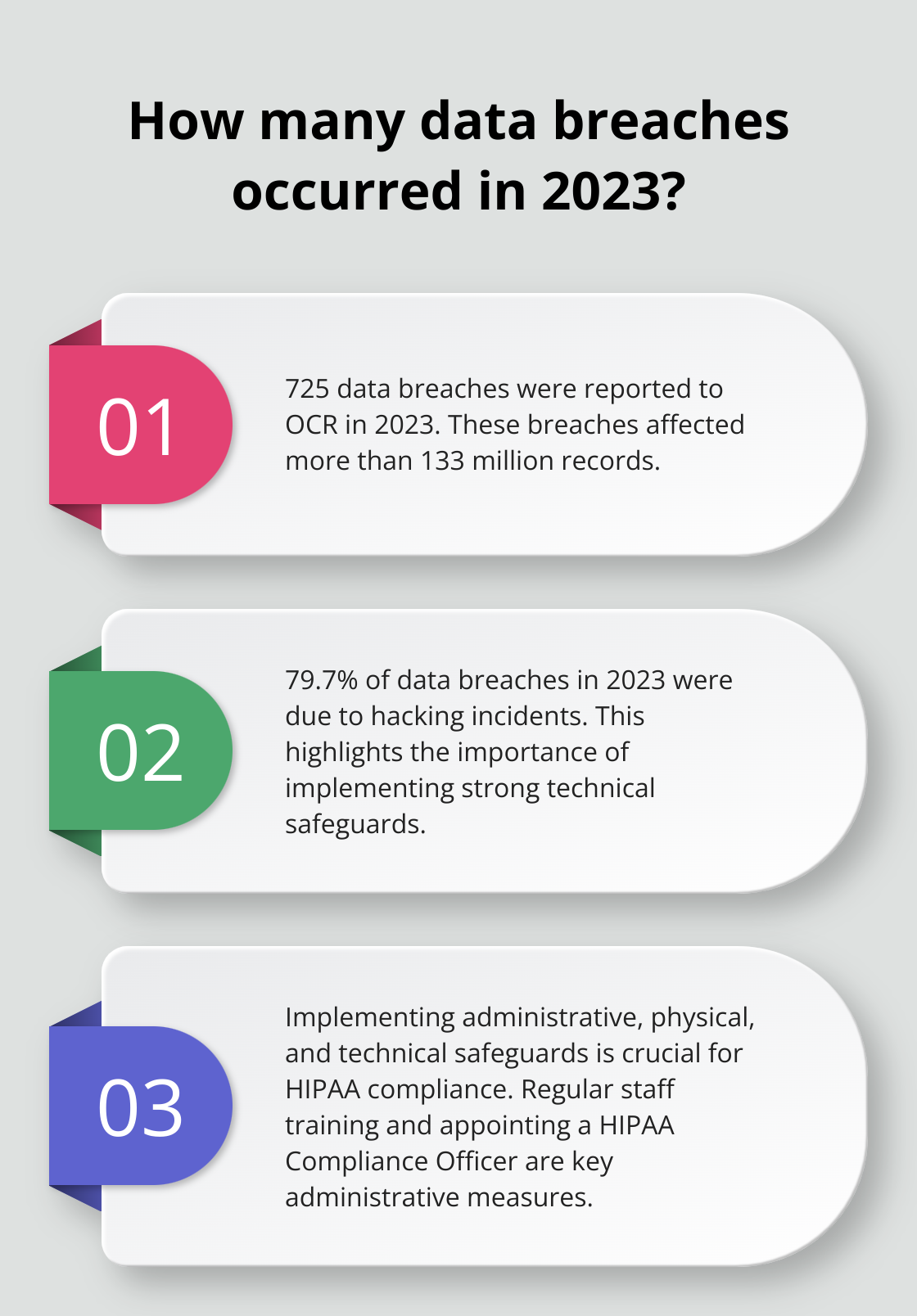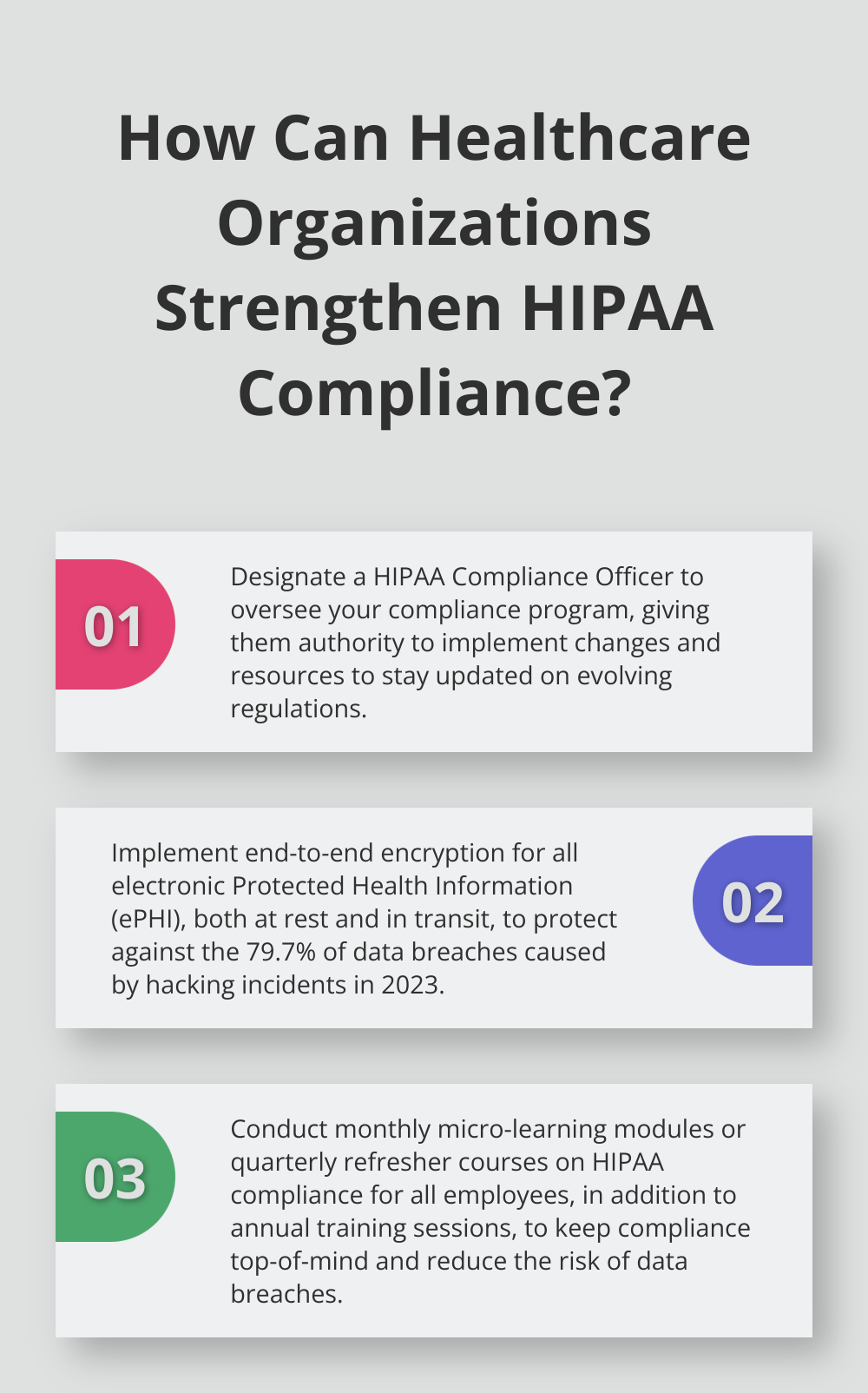Creating a HIPAA compliance plan is essential for healthcare organizations to protect patient data and avoid costly penalties. At ScriberJoy, we understand the challenges of navigating complex regulations.
This guide will walk you through the key steps to develop an effective HIPAA compliance plan, from understanding requirements to implementing safeguards. We’ll provide practical tips to help you secure protected health information and maintain compliance.
What Are HIPAA Compliance Requirements?
HIPAA compliance requirements form the foundation of patient data protection in healthcare. The Health Insurance Portability and Accountability Act (HIPAA) establishes strict standards for safeguarding Protected Health Information (PHI).
Understanding HIPAA Rules
The HIPAA Privacy Rule governs the use and disclosure of PHI. It requires healthcare providers to implement safeguards to protect patient privacy and limits the use of patient information without authorization. The HIPAA Security Rule focuses specifically on electronic PHI (ePHI), mandating administrative, physical, and technical safeguards to ensure the confidentiality, integrity, and availability of ePHI.
Identifying Protected Health Information
PHI includes a wide range of patient data. This encompasses:
- Names and addresses
- Dates (except year)
- Phone numbers and email addresses
- Social Security numbers
- Medical record numbers
- Health plan beneficiary numbers
- Account numbers
- Certificate/license numbers
- Vehicle and device identifiers
- Web URLs and IP addresses
- Biometric identifiers
- Full-face photographs
- Any other unique identifying number, characteristic, or code
Essential Components of a HIPAA Compliance Plan
A robust HIPAA compliance plan must include several key elements:
- Designate a HIPAA Privacy Officer and a HIPAA Security Officer (these roles can be filled by the same person in smaller organizations).
- Conduct a thorough risk analysis to identify potential vulnerabilities in your PHI handling processes.
- Develop and implement policies and procedures that address HIPAA requirements, including privacy practices, security measures, and breach notification protocols.
- Provide regular staff training. The U.S. Department of Health and Human Services recommends annual training sessions at a minimum. Document all training efforts meticulously.
- Implement access controls to ensure that only authorized personnel can view or modify PHI.
- Encrypt ePHI both at rest and in transit to protect against unauthorized access.
- Establish a process for patients to request access to their health information and to file complaints about privacy practices.
- Create and maintain Business Associate Agreements with any third-party vendors who handle PHI on your behalf.
- Develop an incident response plan to address potential data breaches promptly and effectively.
Moving Forward with HIPAA Compliance
Understanding HIPAA compliance requirements is just the first step. The next critical phase involves conducting a comprehensive risk assessment to identify potential vulnerabilities in your organization’s handling of PHI. This assessment will serve as the foundation for implementing effective safeguards and creating a tailored compliance strategy.

How to Conduct a HIPAA Risk Assessment
Identify Potential Vulnerabilities
A HIPAA risk assessment starts with a comprehensive mapping of all PHI touchpoints in your organization. This includes electronic systems, paper records, and verbal communications. Don’t overlook common vulnerabilities such as personal devices used for work purposes. A survey revealed that 82% of organizations actively enable BYOD to at least some extent, potentially increasing the risk of data breaches.
Evaluate Current Security Measures
After identifying vulnerabilities, assess the effectiveness of your existing security measures. This evaluation should cover administrative, physical, and technical safeguards.

For administrative safeguards, review your policies and procedures. Are they comprehensive and up-to-date? The Office for Civil Rights (OCR) cites inadequate policies and procedures as a top reason for HIPAA violations.
Physical safeguards include measures like locked file cabinets and secure server rooms. A Ponemon Institute study found that 52% of data breaches were caused by malicious attacks.
Technical safeguards involve encryption, access controls, and audit logs. The 2022 HIMSS Cybersecurity Survey showed that only 69% of healthcare organizations encrypt data at rest, leaving a significant portion of PHI vulnerable.
Document Findings and Prioritize Risks
Meticulous documentation of all findings serves as evidence of your compliance efforts and provides a roadmap for improvements. Prioritize risks based on their potential impact and likelihood of occurrence. High-impact, high-likelihood risks should receive immediate attention.
A risk matrix can help visualize and categorize your findings, aiding in communicating risks to stakeholders and allocating resources effectively.
Conduct Regular Assessments
A risk assessment isn’t a one-time event. The healthcare landscape and cyber threats evolve rapidly. The Department of Health and Human Services recommends conducting risk assessments at least annually or whenever significant changes occur in your organization.
Leverage Technology for Risk Assessment
Consider using specialized software tools to streamline your risk assessment process. These tools can help automate data collection, analysis, and reporting (making the process more efficient and accurate). While there are many options available, we recommend exploring ScriberJoy’s features, as it offers HIPAA-compliant solutions tailored for healthcare providers.
A thorough risk assessment forms the foundation of a robust HIPAA compliance plan. The next step involves implementing effective safeguards based on your assessment findings. Let’s explore how to put these safeguards into action to protect your patients’ sensitive information.
Implementing HIPAA Safeguards: A Practical Guide
After you conduct a thorough risk assessment, you must implement robust HIPAA safeguards. These safeguards protect patient data from unauthorized access, use, or disclosure. Let’s explore practical ways to implement administrative, physical, and technical safeguards effectively.
Administrative Safeguards: The Foundation of HIPAA Compliance
Administrative safeguards include the policies, procedures, and training programs that govern how your organization handles PHI. Start by developing clear, comprehensive policies that address all aspects of HIPAA compliance. These should cover topics like data access, breach notification procedures, and employee responsibilities.

Staff training is essential. The Office for Civil Rights reports that in 2023, 725 data breaches were reported to OCR, affecting more than 133 million records. Implement a rigorous training program that goes beyond annual sessions. Consider monthly micro-learning modules or quarterly refresher courses to keep HIPAA compliance top-of-mind for all employees.
Appoint a HIPAA Compliance Officer to oversee all aspects of your compliance program. This individual should have the authority to implement changes and the resources to stay updated on evolving HIPAA regulations.
Physical Safeguards: Securing the Tangible Environment
Physical safeguards protect PHI from unauthorized physical access. Start by conducting a thorough audit of your facility. Identify all areas where PHI is stored or accessed (including server rooms, filing cabinets, and workstations).
Implement a robust access control system. This could range from key card systems for larger facilities to simple lock-and-key solutions for smaller practices. The key is to ensure that only authorized personnel can access areas containing PHI.
Don’t overlook workstation security. Position computer screens away from public view and use privacy screens where necessary. Implement a clean desk policy to ensure that physical documents containing PHI are securely stored when not in use.
Technical Safeguards: Leveraging Technology for Data Protection
Technical safeguards involve the use of technology to protect ePHI. Encryption is a critical component. According to the HIPAA Journal, in 2023, 79.7% of data breaches were due to hacking incidents. Implement end-to-end encryption for all ePHI, both at rest and in transit.
Access controls are equally important. Implement role-based access control (RBAC) to ensure that employees can only access the minimum necessary information required for their job functions. Use strong, unique passwords and consider implementing multi-factor authentication for added security.
Audit controls provide visibility into who accesses PHI and when. Implement robust logging and monitoring systems to track all access to ePHI. Regularly review these logs to identify any unusual patterns or potential security incidents.
Regularly review and update your safeguards to address new threats and changes in your organization. This proactive, comprehensive approach to HIPAA safeguards will significantly reduce the risk of data breaches and ensure the privacy and security of your patients’ sensitive information.
Final Thoughts
Healthcare organizations must create an effective HIPAA compliance plan to protect patient data and maintain regulatory compliance. This plan requires a thorough understanding of HIPAA requirements, regular risk assessments, and the implementation of robust safeguards. Organizations should monitor, update, and train staff continuously to address evolving threats and regulatory changes.

A well-implemented HIPAA compliance plan enhances patient trust, improves data management, and leads to more efficient operations. It also provides a solid foundation for addressing other data protection regulations, positioning organizations for long-term success in the data-driven healthcare landscape. Technology solutions can streamline HIPAA compliance efforts significantly.
ScriberJoy offers HIPAA-compliant medical transcription software that combines AI accuracy with human verification. This tool helps maintain precise and secure patient documentation (while enhancing efficiency and data protection in daily operations). Healthcare providers who integrate such tools into their HIPAA compliance plan demonstrate their commitment to excellence in healthcare delivery.

Leave a Reply
You must be logged in to post a comment.